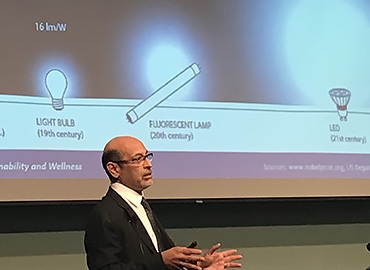In the 63rd annual UC Santa Barbara Faculty Research Lecture, delivered Monday, November 26, Professor Umesh Mishra (electrical and computer engineering) explained to a large audience at Corwin Pavilion why we should, as he titled his talk, “Thank God for GaN.” Being selected to present the Faculty Research Lecture is the highest honor bestowed upon UCSB professors in recognition of extraordinary scholarly distinction.
After being introduced by Chancellor Henry Yang, Mishra spent the next hour explaining why he believes the semiconductor gallium nitride (GaN), which has been the subject of extensive research in the UCSB College of Engineering, is destined to replace silicon as the most important semiconductor material in the world. That would be especially good for UCSB, he added, because “We have pioneered the technologies of these materials.”
He began with recalling that Shuji Nakamura, while working in Japan before becoming a UCSB faculty member, used GaN to invent the blue LED in 1993, which enabled the white LED, which revolutionized lighting around the world and earned Nakamura a Nobel Prize.
“Shuji’s revolution with LED cannot be overstated,” Mishra said. “Efficiency is the best way to minimize the need to produce more power; it is key to a healthy planet. Over forty percent of electricity used now in the U.S. will be saved in 2030 by widespread deployment of LEDs.”
Since the blue LED emerged, GaN has enabled LED and laser lighting applications in consumer electronics, optical switches and circuits, lidar, medicine, space flight, and national defense. When the U.S. Navy needed better radar to identify missiles being launched from mountain caves, UCSB developed GaN-based radar, which was five times more powerful than existing systems. Now, twenty years later, Mishra explained, the Navy is switching its entire radar platform to be based on GaN.
Why does GaN work so well? One reason, Mishra said, is related to defects, known as “dislocations,” which are highly undesirable in most semiconducting materials, because they negatively affect performance. GaN is filled with dislocations, but because they are stable, materials scientists can design around the imperfections.
To have widespread application, Mishra said, “A semiconductor has to be high performance based on where it will be used. It has to be very reliable, and it has to get cheaper with every generation of an application.”
As a case in point, he noted, “LED lights were once twenty dollars each. Now they are about a dollar. The adoption of LEDS is one of fastest technological shifts in human history.
“We are all cost sensitive,” he continued. “People on Amazon don’t go for the highest-cost item. That applies to semiconductors, too. But to get low cost, you have to have wide market penetration. You cannot have only one application and hope for it to be low cost. It has to permeate all the application sets. I believe very strongly that GaN satisfies all these requirements.”
Mishra described GaN as a “future-based” material capable of performing successfully in electronics that must operate in extreme environments, mentioning as examples, sensors in jet engines and electronics in spacecraft, like NASA’s InSight, which landed on Mars the day of his talk.
LEDs are used in automobile lighting, for decorative lighting, in cell phones, and in all kinds of displays. At indoor farms, or “plant factories,” where growth is propelled by LED lights, plants grow two and a half times faster than outdoors, use one percent as much water, and produce yields fifty to ninety percent higher than plants grown outside. GaN-enabled LEDs are used to purify water, and will soon make Santa Barbara’s Riviera movie theater a laser theater. They are used in lidar for autonomous vehicles.
Because they are efficient, GaN-based electronics burn cooler, so devices that incorporate them don’t need large, expensive heat sinks. They can therefore be smaller and cheaper. Transistors are expensive. GaN transistors are more efficient so that fewer are needed in electronics applications.
GaN is also very efficient at converting the AC current (from a wall outlet) to the DC current that drives devices like home computers. Conversion inefficiencies currently account for about $40 billion worth of wasted energy in the U.S. every year, equal to the annual energy produced by 318 coal plants. Better conversion efficiency means less wasted electricity, reduced need to produce energy, and, again, lower cost.
Because gallium nitride is a nearly perfect conductor when “on” and a nearly perfect insulator when “off,” it can be used to make excellent switches. The mobility rating of GaN, a measure of how easily an electron moves across the material, which generates functionality, is 2000, twice the rating for silicon, which is currently the world's dominant semiconductor.
Mishra provided example after example of GaN’s abilities as a powerful semiconductor workhorse that fuels energy efficiency, which leads to size and cost reductions and superb scalability. Finally, he concluded, “Silicon is what we have today. GaN is where I’m putting my faith for tomorrow.”

Umesh Mishra presents the 2018 Faculty Research Lectur, "Thank God for GaN."
